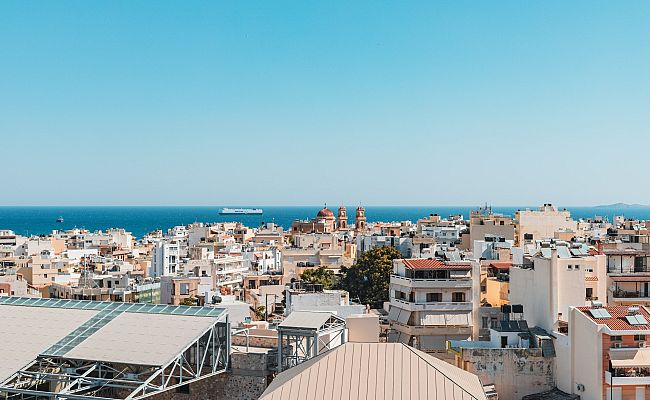Hersonissos is the epitome of an ideal destination with beaches for all tastes and an active nightlife. But it was not always a popular resort: even 1500 years ago, Minoan settlements were located here. And this means that both in the city itself and in the immediate vicinity there is something to see. What sights of Hersonissos are worth getting into the route of every tourist?
Basilica of Kastri
In the 5th century, the early Christian basilica of Kastri was among the largest in Crete. Previously, a basilica destroyed by an earthquake stood in its place, and even earlier, a Hellenistic sanctuary. It was discovered only at the beginning of the 20th century, and excavations began in the 50s. For centuries, Castries has been “conserved” underground, so its mosaic floors with floral and geometric ornaments are well preserved. On the south side of the basilica is a rock-cut chapel. It is believed that this is the burial place of an outstanding clergyman or martyr. Next to the basilica is a small church of St. Paraskeva, the doors of which are always open.
Additional information: Kastri is located on the hill of the same name. It offers views of the whole of Hersonissos, the lighthouse and the nearest beaches
Infrastructure nearby: within walking distance: boat rental services, travel agencies, nightclubs, restaurants and hotels.
Roman fountain
On the embankment of Hersonissos is one of the few surviving Roman monuments - the fountain of Sarakino. This is part of a large complex of similar structures and an ancient villa that has not survived to this day. The fountain is decorated with mosaics depicting a fishing scene, octopuses, birds and fish. If you look closely, you can discern many other plots. Based on the style and theme of the mosaics, the fountain dates back to the 2nd century. It fits into the modern life of Hersonissos - you can look at it and touch the past of Crete while walking around the city.
Infrastructure nearby: Sarakino is surrounded by cafes and shops, in the heart of Hersonissos
Aquaworld Aquarium
One of the city's most popular attractions is the Aquaworld Aquarium. Whole families come here to have fun surrounded by animals. Among the inhabitants are exotic fish and reptiles. But among other things, the aquarium is engaged in rescuing animals in difficult conditions. Visitors can see:
- giant snakes;
- turtles;
- octopuses;
- iguanas.
Some inhabitants are allowed to be fed.
Additional information: Aquaworld is open from April 1 to October 31, daily (except Mondays), from 10:00 to 17:15
Museum "Lychnostatis"
In 1992, the collector Giorgos Markakis founded the Lychnostatis open-air museum in Hersonissos, dedicated to the life and traditions of Crete. Here visitors immerse themselves in the world of Greek crafts and can visit a weaving workshop, a shepherd's hut and an exact copy of the house of wealthy Cretans, a winery, an oil mill and an apiary. There is a small chapel and a mill. The museum serves as a guide to the past of Crete and attracts all those interested in the culture and history of the island.
How to get there: the museum is located on the outskirts of the city, 7 km from the center. You can get to it by taxi or by the tourist mini-train Train Tour from the port.
Additional information: Lychnostatis is open daily (except Saturday), from 9:00 to 14:00. In the period from November 1 to March 31 visits shouldbe pre-booked.
Ano Hersonissos
The old part of Hersonissos differs from the coastal one: here life flows measuredly. You can spend time wandering the narrow alleys and looking at the stone houses, and then visit two churches built in the Byzantine style. The center of Ano Hersonissos is a picturesque square, around which taverns of traditional Cretan cuisine are concentrated. In the summer season, live concerts with national dances and music are held here in the evenings.
How to get there: Ano Hersonissos is located 2 km from the coastal Hersonissos. You can get there by taxi or on foot (about 25 minutes walk)
Infrastructure nearby: although there are no noisy bars and clubs in the Old Town, taverns and small hotels work here. Some have swimming pools with beautiful panoramic sea views.
The villages of Piskopiano and Koutouloufari
For those who plan to see the sights of Crete by car, from Hersonissos you can go on dozens of exciting routes. The villages of Piskopiano and Koutouloufari are located 2 km from the resort area. The first began its history during the Middle Ages and retained the traditional Cretan architecture. Worth a stroll through the streets of Piskopiano and visit the Museum of Rural Life with a collection of weaving art. And Koutulufari attracts with old houses with arched openings and picturesque courtyards.
Infrastructure nearby: in the villages there are shops, taverns and mini-hotels, many of which work in restored houses.
Cave Skotino
16 km from Hersonissos is the cave of St. Paraskeva (or Skotino). It is one of the largest caves in Crete: it reaches a height of 10 m and a width of 27 m. In ancient times, Skotino was used as a place of worship, and Christian rites replaced pagan rites. Near the cave today there is a temple built on the foundations of a Venetian church. Inside Skotino impresses with a variety of stalagmites and majestic rocks of various shapes. This decoration, combined with excellent acoustics, makes it clear why in the past this cave was important to the inhabitants of Crete.
How to get there: by car, leave Hersonissos in a western direction, move through the villages of Gouves and Skotino.
Infrastructure nearby: the cave is not one of the most popular tourist places. Therefore, it is worth taking care of the presence of comfortable shoes and a flashlight. 4 km from the cave are the villages of Skotino and Gouves, where you can find taverns and shops.









